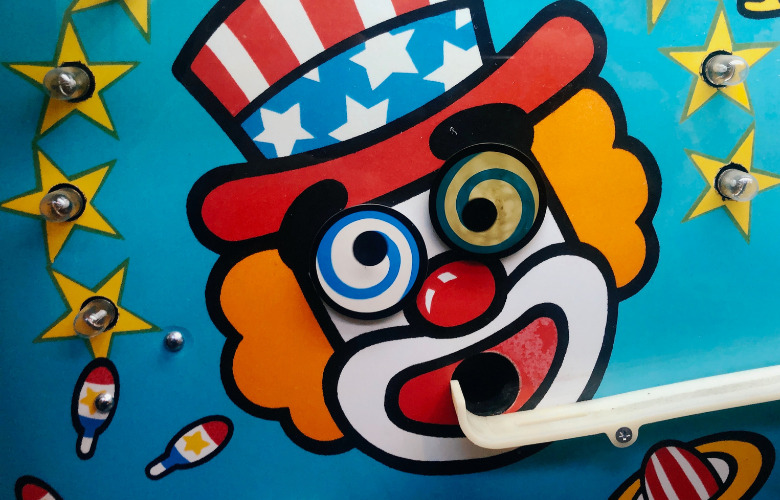
Clowns… they have been called tricksters and jesters as well. We’ve all seen them. In the circus, on the streets, at children’s birthdays, in hospitals… Besides providing excellent entertainment, clowns are an important figure due to the influence they have on us. Amazingly, they bring us far more than just laughter. Instead, they trigger a whole range of emotions. Joyful amazement. Sadness. Sometimes, even irrational fear. This is a brief look into their history and mythology.
Clowns are mentioned in the history books going back thousands of years. Jesters, for example date back at least as far as ancient Egypt.
Jesters and clowns developed from the mythological figures of “tricksters.”
Tricksters are archetypal characters who appear in the myths of many different cultures around the world.
They cross and often break both physical and societal rules. They are known to challenge principles of social and natural order. Playfully, they disrupt life as we know it to then re-establish it on an alternate basis.
The trickster is also unconstrained by form or gender. In Norse mythology, the trickster Loki is a shape shifter who could move freely between genders. At one point, he even became a mare who later gave birth to Odin’s eight-legged horse.
In later worldwide folklore, the trickster is incarnated as a clever man or creature, who defends himself by using trickery to survive the dangers of the world.
It was around then that they became known under a new name: jesters.
Early jesters were popular in Ancient Egypt and entertained Egyptian pharaohs.
The Romans also had a tradition of professional jesters. In their society, these individuals were called Balatrones. They moved freely in the company of high society members due to their talent to amuse and distract.
In the 11th and 12th centuries in Europe, the title minstrel (“little servant”), was the name for a wide range of entertainers, including singers, musicians, jugglers, tumblers, magicians, and jesters.
Both, men and women, were employed as minstrels and there is a record of a female jester called Adeline owning land in Hampshire in 1086.
In the 12th century, the title of follus or “fool” began to be mentioned in documents, often when these jesters had been rewarded with land as payment for loyal service.
By the 13th century, some talented jesters were beginning to achieve superstar status. In Europe and India, the most eminent jesters were household names. Just as famous as stand-up comedians are today.
The jesters in China seem to have been celebrities as well. In some biographies and historical texts, it is mentioned that the jokes of jesters were passed around among ordinary people and that everyone was quite dazzled by them.
One such Chinese jester recorded in history was Dongfang Shuo. Court jester to emperor Wu during the Han Dynasty.
An individual court jester in Europe could emerge from a wide range of backgrounds: a university dropout, a monk thrown out of a priory, a juggler, an acrobat, or maybe an apprentice in a shop or craft who was fooling around too much.
Important was that these individuals had exceptional verbal communication skills, as well as physical dexterity to be noticed by noblemen and find success.
Most jesters during these ancient times doubled as entertainers and advisors. However, they advised largely through their art, in a diplomatic, metaphorical manner.
Jesters were believed to be neutral observers. They stayed at the periphery of the game of politics. This reassured many a king that their jester’s words were not spoken with ulterior motives.
Jesters were able to soften the blow of a critical comment in a way that prevented a dignified personage from losing face. Humor was and always will be the great antidote to tense situations.
For example, amongst the Aboriginal Murngin tribe in Australia, it is the duty of the clown to act outrageously if men are drawn into a conflict. It makes everyone laugh, confuses, defuses, and pacifies the aggressors.
In the early Middle Ages in Europe, jesters were expected to accompany their kings and masters to the battlefield in times of war.
The jesters’ job was to wage psychological warfare. The night before battle, they boosted their army’s morale with songs and stories.
Then, the next morning, when the two armies took up their opposing positions, the jesters would race up and down on foot or horseback between them. Their mission was to calm the nerves of their own men by making them laugh at jokes or sing songs.
At the same time, the jesters would also shout mock abuse to their enemies to demoralize them. A dangerous job as you can imagine. Quite a few jesters were killed on those battlefields.
This developed out of earlier comedic roles in theatre or comedy shows during the 19th to mid 20th centuries.
Then as well as today, many circus clowns have become well known. Many are a key circus act.
The first mainstream clown role was portrayed by Joseph Grimaldi (1778 – 1837). He also created the traditional whiteface make-up design.
In the early 20th century, with the disappearance of the rustic simpleton or village idiot character of everyday experience, North American circuses developed characters such as the tramp or hobo.
Examples include Charlie Chaplin’s The Tramp (1914), and Emmett Kelly’s Weary Willie based on hobos of the Depression era.
The 1980s gave rise to the evil clown character.
Often, children are afraid of clowns. Many adults as well are known to have a clown phobia. Authors like Stephen King began to explore this phenomenon in their stories.
In our time, researchers have explored as to where the fear of modern-day colorful clowns under their white masks and large red noses comes from. They conclude is deindividuation is a major factor. A state in which one’s identity is hidden.
For example, during Mardi Gras, a costume party, or if you are online in an anonymous chat room, you and everyone else there are deindividuated, too.
When a clown wears a mask covering their face and never revealing their identity, they are also deindividuated. And, for some, this may trigger age-old instinctive fight or flight responses. Maybe the deindividuated individual will dare to take actions they normally never would.
Deindividuation is one of the hallmarks of clowns. They wear baggy outfits, large wigs and full make-up with a fake nose which obscures their faces even further. Their true identity becomes something far removed. Irrelevant even for the spectator.
And, as in the days of old, clowns still thematize not only joy, but also pain, sadness, societal norms, stereotypes, and problems. All under the guise of humor.
Some years ago, a friend of mine who performs as a clown summed the ambivalence up quite nicely.
“The impact of a clown is not due to his being funny. It is due to us feeling that underneath the slapstick and humor there is an abundance of pain and sadness. Challenges, just as there are in everyone’s real lives.”
“We laugh with relief and sometimes also unease as the clown reveals what lies beneath for those who want to see. At the same time the clown shows the audience to laugh in the face of adversity. He shows them that life goes on. That it always will. And that it shouldn’t be taken too seriously.”
Based in part on the article “The Trickster, the Jester, the Clown: The Brief Mythology and Ancient History of the Harbingers of Laughter and Fear” as well as countless other online resources…
“Love Art in Yourself” A Collection of Beautiful Theatre Quotes
The Covid Odyssey of a Stage Manager – Part 1


Liam Klenk was born in Central Europe and has since lived on four continents. Liam has always been engaged in creative pursuits, ranging from photography and graphic design, to writing short stories and poetry, to working in theatre and shows. In 2016, Liam published his first book and memoir, 'Paralian'.
Read Full Profile© 2021 TheatreArtLife. All rights reserved.

Thank you so much for reading, but you have now reached your free article limit for this month.
Our contributors are currently writing more articles for you to enjoy.
To keep reading, all you have to do is become a subscriber and then you can read unlimited articles anytime.
Your investment will help us continue to ignite connections across the globe in live entertainment and build this community for industry professionals.